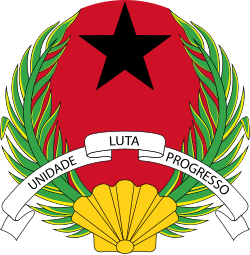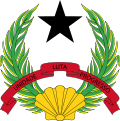This article needs additional citations for verification .(May 2019) |
| Emblem of Guinea-Bissau | |
|---|---|
 | |
| Versions | |
 | |
| Armiger | Republic of Guinea-Bissau |
| Adopted | 1973 |
| Shield | Gules, in chief a Mullet or five points Sable |
| Supporters | Two wreathes of laurel proper |
| Compartment | A seashell Or |
| Motto | Unidade, Luta, Progresso (Portuguese: "Unity, Struggle, Progress") |
The Emblem of Guinea-Bissau was adopted shortly after independence from Portugal in 1973.





